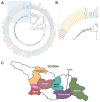Genomic Surveillance of Rabies Virus in Georgian Canines
- PMID: 37766204
- PMCID: PMC10537093
- DOI: 10.3390/v15091797
Genomic Surveillance of Rabies Virus in Georgian Canines
Abstract
Rabies is a fatal zoonosis that is considered a re-emerging infectious disease. Although rabies remains endemic in canines throughout much of the world, vaccination programs have essentially eliminated dog rabies in the Americas and much of Europe. However, despite the goal of eliminating dog rabies in the European Union by 2020, sporadic cases of dog rabies still occur in Eastern Europe, including Georgia. To assess the genetic diversity of the strains recently circulating in Georgia, we sequenced seventy-eight RABV-positive samples from the brain tissues of rabid dogs and jackals using Illumina short-read sequencing of total RNA shotgun libraries. Seventy-seven RABV genomes were successfully assembled and annotated, with seventy-four of them reaching the coding-complete status. Phylogenetic analyses of the nucleoprotein (N) and attachment glycoprotein (G) genes placed all the assembled genomes into the Cosmopolitan clade, consistent with the Georgian origin of the samples. An amino acid alignment of the G glycoprotein ectodomain identified twelve different sequences for this domain among the samples. Only one of the ectodomain groups contained a residue change in an antigenic site, an R264H change in the G5 antigenic site. Three isolates were cultured, and these were found to be efficiently neutralized by the human monoclonal antibody A6. Overall, our data show that recently circulating RABV isolates from Georgian canines are predominantly closely related phylogroup I viruses of the Cosmopolitan clade. Current human rabies vaccines should offer protection against infection by Georgian canine RABVs. The genomes have been deposited in GenBank (accessions: OQ603609-OQ603685).
Keywords: RABV; canine; dog; genomics; jackal; lyssaviruses; neutralization; next-generation sequencing; phylogeny; rabies.
Conflict of interest statement
The authors declare no conflict of interest.
Figures




Similar articles
-
Molecular genetic characterization of rabies virus glycoprotein gene sequences from rabid dogs in Bangkok and neighboring provinces in Thailand, 2013-2014.Arch Virol. 2016 May;161(5):1261-71. doi: 10.1007/s00705-016-2789-8. Epub 2016 Feb 18. Arch Virol. 2016. PMID: 26887972
-
Rabies outbreak in black-backed jackals (Canis mesomelas), South Africa, 2016.Epidemiol Infect. 2022 Jan 7;150:e137. doi: 10.1017/S0950268821002685. Epidemiol Infect. 2022. PMID: 35900135 Free PMC article.
-
Evolutionary analysis of rabies virus isolates from Georgia.Arch Virol. 2022 Nov;167(11):2293-2298. doi: 10.1007/s00705-022-05550-3. Epub 2022 Aug 1. Arch Virol. 2022. PMID: 35913651
-
Integrating one health strategies for rabies control: Insights from Jackal-mediated human rabies in Northeast India.Comp Immunol Microbiol Infect Dis. 2025 Jan;116:102287. doi: 10.1016/j.cimid.2024.102287. Epub 2024 Nov 29. Comp Immunol Microbiol Infect Dis. 2025. PMID: 39647436
-
Genomic characterization of a dog-mediated rabies outbreak in El Pedregal, Arequipa, Peru.PLoS Negl Trop Dis. 2025 Mar 5;19(3):e0012396. doi: 10.1371/journal.pntd.0012396. eCollection 2025 Mar. PLoS Negl Trop Dis. 2025. PMID: 40043048 Free PMC article.
Cited by
-
Histopathological and immunohistochemical examination of the brains of rabid dogs in the Philippines.J Vet Med Sci. 2024 Dec 1;86(12):1243-1251. doi: 10.1292/jvms.24-0249. Epub 2024 Oct 8. J Vet Med Sci. 2024. PMID: 39384379 Free PMC article.
References
-
- Benavides J.A., Valderrama W., Recuenco S., Uieda W., Suzán G., Avila-Flores R., Velasco-Villa A., Almeida M., de Andrade F.A., Molina-Flores B., et al. Defining New Pathways to Manage the Ongoing Emergence of Bat Rabies in Latin America. Viruses. 2020;12:1002. doi: 10.3390/v12091002. - DOI - PMC - PubMed
MeSH terms
Substances
Grants and funding
LinkOut - more resources
Full Text Sources
Medical

